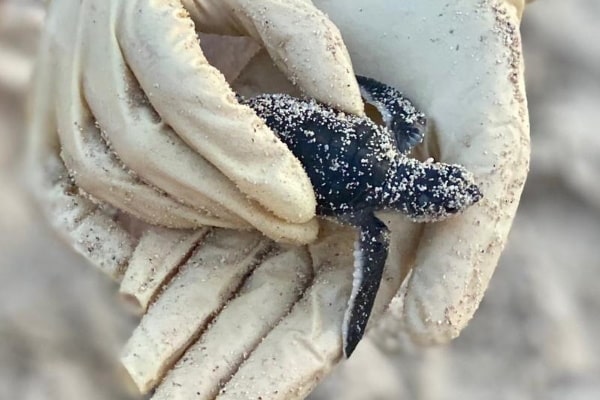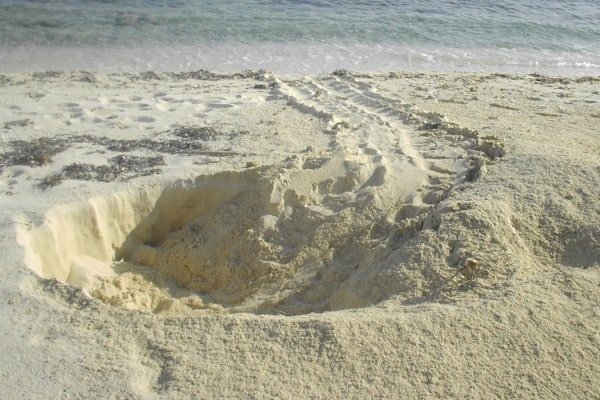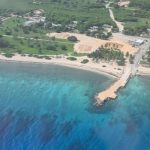More than 550 turtle nests break season records
(CNS): The year 2020 will go down in history for many reasons but it has also made the record books here for the length of the wild turtle nesting season and number of nests found on the islands’ beaches. Across Grand Cayman and Cayman Brac, Department of Environment staff and volunteers counted 557 nests and almost 62,000 eggs in a season that began with a loggerhead nest spotted on Seven Mile Beach by the police chopper crew in April during lockdown and ended with the discovery of a Christmas Eve hawksbill nest on the Brac.
Despite the good news, the endangered green, critically endangered hawksbill and vulnerable loggerhead turtles all face immeasurable threats to their survival. Experts believe the leatherback turtle is now extinct in our area.
While the overall number of nests for 2020 was likely even higher than recorded, because there was no count on Little Cayman this year due to the pandemic, poaching and beach erosion remained a major problem and the number of nesting females is still relatively small.
Ultimately, the fate of wild turtles, remains precarious, the DoE said in a release about the season. DoE enforcement offers were able to intercept some poaching attempts and saved a number of turtles. But the unexpected reprieve given to the marine environment during the lockdown and continued tourism shut-down was cancelled out in some respects by the severe beach erosion from late season storms.
The measures taken to prevent the spread of COVID-19 resulted in turtles nesting in new locations. But despite major efforts by the DoE to relocate dozens of nests that were vulnerable because of the weather, later in the season high seas and the dramatic beach erosion resulted in more that 30 nests being inundated and some lost.
Green turtles fared the best out of the three remaining species that still nest here. On Grand Cayman, out of 506 confirmed nests, 345 were green turtle, the best on record, 156 were loggerhead and five were hawksbill nests. On Cayman Brac there were 51 confirmed nests, including 41 loggerhead, eight green and two hawksbill. Aside from a new record for the number of nests on the Brac, the Christmas Eve nest was also the latest on record for all three islands.
The record breaking season was made possible only because it was documented and that was done with the support of more than 40 regular volunteers ,who walked beaches to report tracks, assisted with data collection and helped DoE staff protect the nests.
See the statistics for the season below:
Grand Cayman:
- Total season length (nesting and hatching): 7 months and 24 days
- Total confirmed nests: 506 (156 loggerhead, 345 green, and 5 hawksbill)
- Total eggs counted: 56,290
- Total hatched egg shells counted: 43,803
- Total nests relocated to protect from storm surge: 53
Cayman Brac:
- Total season length (nesting and hatching): 9 months and 19 days *hatch date estimated for final nest
- Total confirmed nests: 51 (41 loggerhead, 8 green, and 2 hawksbill)
- Total eggs counted: 5,688
- Total hatched egg shells counted: 3,604
- Total nests relocated to protect from storm surge: 8
Season Timeline:
- 19 April: Season began with the first loggerhead nest discovered by the police helicopter aerial footage on Seven Mile Beach during lockdown.
- 4 May: Cayman Brac’s nesting season began with first loggerhead nest.
- 25 May: First green turtle nest on Grand Cayman is the earliest on record. Usually green turtles begin nesting in mid-June.
- 2 September: Nesting record on Grand Cayman is broken with 469th nest.
- 19 September: DoE celebrated the 500th nest on Grand Cayman.
- 4-6 October: Hurricane Delta approaches the Cayman Islands bringing high seas and emergency relocation of 20 nests.
- 24-26 October: Hurricane Zeta brings more bad weather and high seas, threatening and destroying some nests.
- 18 December: Final nest on Grand Cayman is excavated.
- 24 December: Cayman Brac sees late hawksbill nest on Christmas Eve
Category: Land Habitat, Marine Environment, Science & Nature





































Good job DOE.
i might be naive , but could the record number of nests be to do with the much reduced ship traffic from cruise ships and less people on the beaches? im not saying that tourism is the problem, but too much of anything can be a bad thing
Not so much to do with the cruise ships but definitely a reduction in the human presence/foot traffic. Turtles can be scared off if too many people are around. The DOE had a fist this year. There was a nest at smith cove during lockdown. This is very much due to the lack of human activity on the beach!
Good news! Def getting stew turtle for lunch tomorrow to celebrate!
Great news! Def peeing in it when I serve ya.
Thanks a lot R Kelly!
R Kelly pees on women, not food.
Women are food.
We need some statistics from the Turtle Farm, how many employees have been accused of corruption, how long before they will face trial, how much money has disappeared, who will be held accountable for this fiasco?.
Do you really expect anyone at the turtle farm to admit any wrongs???
Do you really expect anyone at the turtle farm to admit any wrongs??? I nominate the turtle farm as the most corrupt branch of the Cayman government! Does anyone think differently?
7.25pm I do believe the turtles are honest.
I love the way you fools rip at the Turtle Farm.
Fully 95% of the turtles creating these nests are directly from the 33,000 that the Turtle Farm has released over the past 40 years.
This has been proven scientifically by DNA testing of all the nesting turtles in Caymans Waters.
Without the Turtle Farm there would be no green turtle nesting activity in Cayman for DOE to monitor and brag about. FACT.